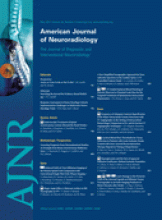In motor neuron diseases (MNDs) such as amyotrophic lateral sclerosis (ALS) and primary lateral sclerosis (PLS), the definition of disease-related MR imaging characteristics is still ongoing. MR imaging approaches based on conventional and advanced techniques are frequently reported, aiming at the visualization of distinct regional patterns of structural or functional damage. Riad et al1 presented MR imaging visualization of the corticospinal tract (CST) and the motor segment of the corpus callosum (CC) in 2 patients with PLS, including region of interest–based quantifications of T2 hyperintense signal-intensity alterations in fluid-attenuated inversion recovery images. The authors compared their observations of circumscribed volume loss and signal-intensity alterations within the posterior body of the CC with the revised topographic scheme by Hofer and Frahm2 and thus confirmed the assumption of motor fiber distribution within this CC area.
However, Riad et al1 do not integrate this finding into the context of several recent studies on the pattern of structural brain alterations associated with different MNDs. In a recent study,3 69 patients with rare MND, including cohorts of 25 patients with PLS and 24 patients with pure hereditary spastic paraparesis (HSP), which are both characterized by a clinically prominent involvement of the upper motor neurons (UMNs), were investigated by computer-based MR imaging approaches using diffusion tensor imaging (DTI). Besides the observation of extensive areas of decreased fractional anisotropy (FA) within the CST in both MND and nonmotor brain regions in HSP, distinct patterns of microstructural integrity deterioration were identified both in PLS within the posterior body of the CC (analogous to the results of Riad et al1) and in HSP within dorsal parts of the CC to an even larger extent. These findings of microstructural disruption of the white matter tracts within the CC in MND with the clinical predominance of UMN impairment were confirmed by application of tractwise FA statistics of the callosal fiber distributions.3 In addition, by application of tract-based spatial statistics (www.fmrib.ox.ac.uk/fsl), Filippini et al4 recently reported the observation of decreased FA within the major tracts of the CC in patients with ALS, which extended rostrally and bilaterally to the region of the primary motor cortices.
Damaged tract integrity within the CC was also observed in patients with ALS by other groups. Beyond microstructural pathology visualized by DTI, decreased volume of the CC in patients with HSP was also observed to be localized in motor segment III, on the basis of voxel-based morphometry of T1-weighted 3D images.5 With respect to these findings within the CC motor section in PLS and HSP, it seems likely that these patients represent one end of a continuum in MND due to the long disease duration. In ALS with its much shorter survival times, microstructural damage (by DTI) but usually no macrostructural atrophy can be visualized.
Thus, advanced MR imaging analyses at a group level seem to be useful for the identification and quantification of pathoanatomic features in terms of noninvasive markers in MND, and DTI-based methods may reflect an additional tool for redefining the pathoanatomy of MND subtypes by microstructural in vivo fingerprint characteristics. In particular, the CC seems to be a key structure in the regional degeneration pattern in MND with a predominance of UMN affectation.
References
- Copyright © American Society of Neuroradiology












